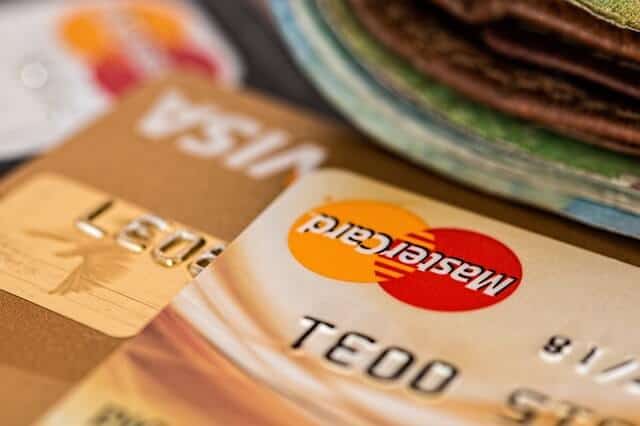Credit cards are a significant part of how we purchase goods and services in the United States. They provide an easy way to pay for items without having cash on hand, which is especially useful when traveling or shopping online where you might not have access to your bank account or wish to carry cash.
However, credit cards can also carry costly risks if not managed properly.
This article will help consumers understand the different types of credit cards available and consider them before selecting one type.
Featured Financial Products
Table of Contents
What Types of Credit Cards and Payment Cards are Available?
Cards divide into many different credit card types. For starters, there are secured cards vs. unsecured cards. The former mostly aims to build or rebuild credit history while the latter can provide ample opportunity to earn rewards, cashback, and more. Or, an unsecured credit card can simply provide financial flexibility against a line of credit.
On unsecured credit cards, you find a wide diversity in the audiences who use these payment cards. Within unsecured cards, you encounter several credit card types geared toward specific goals. Some unsecured credit card types come designed for businesses, while others work best for college students.
Some work best for balance transfers, earning statement credits to increase your cashback, serving as starter credit cards for people with little to no credit history, or even just have a high spending limit. There are also charge cards and single-purpose retail cards.
Each of these card categories has distinct traits and, depending on your financial situation, some of these credit card types will be more advantageous for you than others.
Let’s take a deeper look at the characteristics of each of these cards and how to figure out which are best for you right now.
Secured Credit Cards
A secured credit card is a type of credit card that requires you to put down an upfront cash deposit, usually equaling the amount of your credit limit. This cash security deposit helps protect the credit card company from recognizing a loss by issuing you a credit card and failing to receive payments.
Secured cards typically work best for individuals with no credit or looking to rebuild bad credit. The cash deposit establishes collateral the credit card issuer may claim in the event of default or failure to make on-time payments.
How Does a Secured Credit Card Work?
Often, secured credit cards work as the first step for young adults or people who don’t have an established credit history to have access to credit. They also work for consumers with poor credit.
Secured credit cards work by having the cardholder front a required deposit to open an account, reducing the risk to the credit card issuer of you defaulting or missing a payment. Usually, minimum deposits are in lower denominations, between $200 to $500 to start. This represents your credit limit and also financial protection for the financial institution issuing the card.
Once you apply for a secured credit card and make the security deposit, these secured credit card options work like any other card. Where they differ from a traditional credit card comes through requiring a cash deposit upfront (usually a refundable security deposit) and often running no credit check as a result.
Unsecured credit cards don’t require an initial deposit and usually run a credit check to determine eligibility and whether you are likely to use the card responsibly. A card company may let applicants get automatically considered if their credit profile carries excellent credit or if they apply for a secured card.
Related: 9 Best Credit Cards for No Credit History [Starter Credit Cards]
Unsecured Credit Cards
An unsecured credit card operates under a different model than a secured credit card. Unsecured cards, the most common credit card type, often represent what people want when applying for a new credit card. Unsecured credit card options rely on expenses hitting a line of credit extended to you in advance.
“Unsecured” means that your debt incurred on the unsecured card doesn’t come backed by collateral—a deposit in the case of secured cards—and relies on a borrower’s credit score. That means this type of card has a higher risk to lenders because they rely on your credit history and your ability to repay.
Because you make charges against a line of credit on an unsecured card, they often get referred to as “charge cards.” However, an unsecured credit card, like a secured credit card, still limits how much you can spend through credit card limits.
They also tend to offer users a cashback or a rewards program to entice them to open a credit card account.
Related:
- What is Credit Card Piggybacking & Does It Help Credit Scores?
- Will Authorized User Status Help Build Your Credit Score?
How Do Unsecured Credit Cards Work?
Unsecured credit cards represent a standard financial product available through banks, credit unions and other service providers. They work by providing you with a revolving line of credit, meaning you can spend up to an approved amount without making a payment within a monthly billing cycle.
You can pay off the card in full each monthly billing cycle, or you can revolve it to the next month and incur interest on any unpaid balance. You can make the minimum monthly payment or choose another amount between this and the entire amount due.
Because credit cards carry some of the highest interest rates of any form of credit available, paying off your balance each monthly billing cycle can save you significant amounts of money over time.
Plus, it instills a habit of building a good payment history and, eventually, a good credit score.
Because of the ubiquity of these cards, establishing good money habits pays off significantly through avoided interest expense. You don’t need to look too far to find a credit card through any company remotely related to finance.
Because of this, getting an unsecured card requires you to apply with the financial institution by supplying your personal information and often consenting to a pull on your credit score from the major credit bureaus. Not all card companies require this, but many do.
If the company approves your application, they will provide you with an unsecured credit card to use in various locations, both online and off.
Featured Financial Products
Balance Transfer Credit Card
Balance transfer cards allow you to transfer your high-interest credit card debt to a card with a low introductory annual percentage rate (APR). Sometimes the APR is even 0%, meaning the card user might be able to pay off credit card debt interest-free.
However, that doesn’t mean the entire process is free. Often there is a balance transfer fee based on a percentage of the total transferred, and typically this is between 3% to 5%.
If your current interest rate is much higher than that, and you’re confident you can pay off most or all of your debt before the low APR ends, you can still end up saving a significant amount of money.
You may have to apply for a card with an initial 0% APR offer on balance transfers. Alternatively, you may be able to transfer to a card you already have, or a company might reach out to you and say you’re pre-approved for a balance transfer.
Once you have the new card (or have chosen one you already use), you have to initiate the transfer by phone, online, or sometimes through a balance-transfer check. The transfer may take a couple of weeks to go through.
Once your transfer is complete, you can pay off your balance without all the interest you would have paid each month with the original card. Remember, your 0% APR is just temporary, so it’s essential to try and pay your entire balance before a higher interest rate begins.
Student Credit Cards
Student credit cards function the same as other unsecured credit cards and are a helpful way for young adults to start building credit. The main difference is that these student credit cards specifically target college students and don’t require much, if any, credit history.
These credit cards often have high APRs or annual percentage rates, so it’s essential students don’t overspend and have enough money to cover what they charge once the bills come.
For any college student that has the control to limit credit card spending, a college student credit card is an easy way to build credit and earn rewards. Student credit cards typically start with lower credit limits than other credit cards. If you’re a college student under age 21 and don’t have an independent income, you might need a parent or other adult to co-sign on your credit card application.
Related: Best Credit Cards for Students with No Credit
Rewards Credit Cards
A rewards credit card allows users to accumulate points or credits when they spend money. The more money you spend, the more points you earn. Rewards points can usually be redeemed for cash, flights, hotels, shopping vouchers, and more.
The sign-on bonus can be particularly appealing on a rewards credit card. If you spend enough during your first few months on a new card, you can often get a worthwhile reward. The company wants you accustomed to using their credit cards frequently.
Reward cards often have an annual fee. If you spend enough money with the credit card issuers each year or get other perks from them, the value of your rewards can exceed the fees you pay.
It’s common to have specific categories of purchases earn different amounts of points. For example, you might earn more points at gas stations during a particular period than at grocery stores or vice versa. Note that not everyone can receive approval for a rewards credit card. You usually need to have a good credit score.
There are three major rewards credit cards to know about:
Travel Rewards Credit Cards
A travel rewards credit card lets you earn travel-related rewards and discounts. You might be able to save up enough points to receive a free night at a hotel or discounted airline tickets.
There are other possible perks, such as lounge access or upgraded airline seats as well. Usually, you can accumulate points through any type of purchase and might earn extra points for money spent on travel expenses.
Different airlines and hotel groups have their own travel rewards cards to be used specifically with their brand, but more general travel rewards cards can be redeemed with more options.
With these travel rewards cards, they don’t lock you into a specific hotel or airline.
You still might be limited to major brands and there might be blackout dates. Travel rewards cards often have an annual fee, but if you use the card frequently during the year and have travel planned, these credit cards usually become worth it.
Sign-on bonuses for travel rewards cards can be advantageous, especially if you have significant, upcoming expenses.
Cash Back Rewards Credit Cards
With a cashback rewards credit card, you receive a percentage of your money back on purchases. Some credit cards with cashback have a flat rate for all purchases, such as 2% cashback on everything you buy.
Other cashback credit cards have different percentages for different categories. For instance, you might get 5% at specific grocery stores, 2% back at gas stations, and 1% back for everything else. These categories might remain the same or rotate quarterly.
If you spend a significant amount on these credit cards, you can end up saving a lot of money. Sometimes, but not always, these credit cards have an annual fee, so if you’re a light spender, you need to calculate if you would be likely to make your money back.
You can receive your cashback from your cashback credit cards in several manners, such as a statement credit, paper checks, travel points, online shopping and more.
You might also apply for other credit card offers through credit card issuers that offer cash back at a lower rate without an annual fee.
Sometimes, they might offer the same cashback percentage but without an annual fee, such as with my experience with the Capital One Quicksilver card.
I had a Capital One QuickSilver Card with an annual fee and chose to downgrade to the free version, which came available after I initially applied and received approval.
In the process of losing the annual fee, I also managed to receive better terms. My new credit card had a more robust credit line and better interest rates. With credit cards, it pays to do your due diligence to understand the available options.
Points Rewards Credit Cards
Credit card users earn points when they make purchases with their points rewards credit cards. The value of your points varies with the types of credit cards available. Remember that many points from one card might be worth the same as fewer points on another rewards credit card.
It may sound good to have 10,000 points, but a point could be worth two cents, one cent, half a cent, or another amount, depending on the rewards credit card. You receive points for every dollar you spend, and sometimes specific categories might earn more points than others.
For example, you might earn three points per dollar on travel purchases (such as airfare and hotels) and only one point per dollar on all other purchases.
When it’s time to redeem points on your rewards credit cards, the value may be the same for any type of reward, or there might be incentives to redeem specific rewards. It may be better value to redeem travel offers or merchandise rather than cashback or gift cards.
Featured Financial Products
Business Credit Cards
Business credit cards are used for business expenses and not meant for personal use.
There are several benefits to using a business credit card. Since credit cards keep track of purchases, paying for expenses with a business credit card helps at tax time, and you don’t have to deal with reimbursing employees.
Business credit cards also often have perks, such as cashback at specific stores, such as office supply stores. There might also be travel perks and generous sign-up bonuses redeemed through statement credits or as a check.
It’s common for businesses to need a personal guarantee from the business owner or another business member. A personal guarantee means that person is liable for ensuring all payments and fees are handled regularly. If not, it can harm that individual’s credit score.
Starter Credit Cards
A long credit history and high credit score help get loans approved, receiving lower interest rates and better insurance premiums and terms, and more.
However, at some point, you need to start building credit without a credit history in place to vouch for you.
Starter credit cards are meant for people who have a minimal credit history—or none at all. Your starter card could be a student credit card, secured credit card, or an unsecured credit card designed for people with poor or no credit.
These cards are easier to get approved for but likely have low limits and high interest rates. They work well as the boost you need to get approved for other credit cards and more later in life.
You might need to balance a student credit card with student loans, rent, utility and others expenses in life. Make sure you can stay within your spending limit, keep a healthy emergency fund in your bank account and make your monthly payments on time.
Starter credit cards offer an entryway into other credit card types with more generous terms. Though, if you can’t handle a credit line in your name at all, sometimes sticking with cash or a debit card can provide you the best control over your finances.
Related:
Credit Cards for No Credit History
Often, credit card companies will advertise cards you can get without having a credit history. They want you to get your first credit card with them because then you’re likely to keep using their brand in the future.
Without credit, you can show these companies your ability to pay by sharing your income, showing your bank account is in good standing and having an employment history.
While your credit limit may start low, you can get your limit increased after you consistently make on-time payments. Sometimes this is automatic, and other times you need to request the change.
Featured Financial Products
Subprime Credit Cards
Subprime credit cards are meant for users with poor credit. Usually, subprime credit is considered to be in the 580 to 669 range. A common reason people fall in this range is that they had to declare bankruptcy, often following medical emergencies.
These cards have substantially higher interest rates than other credit card types to match the risk to the lender.
Considering the interest rates can get as high as 30%+, it’s vital only to use these types of credit cards if you’re confident you can make regular payments. Sometimes, an upfront deposit is required as well.
Charge Cards
Charge cards are the original type of plastic money, and they require the user to pay for each purchase in full before the end of a billing period.
Most charge cards cannot accrue interest from one month to the next, but there are exceptions. These credit card types typically have a higher credit limit than other credit cards and higher annual fees, and they often have generous rewards.
A charge card is an excellent option for people who worry about a card negatively affecting their credit scores. A high utilization rate with a charge card doesn’t harm your credit score, and timely payments can boost your score.
0% Intro APR Credit Cards
A 0% Intro APR credit card doesn’t charge any interest for a set amount of time. It may last about six months on the low end, and on the high end, it could last a year and a half, or even a bit longer.
After the introductory period ends, you begin paying a more standard rate or a slightly higher than average rate. You encounter no extra costs as long as you pay the minimum balance during the introductory 0% rate. You do still need to pay the minimum, however, and eventually the entire balance.
These cards help if you have a significant purchase you need to make that you’ll need a few months to pay off.
Plan so you can pay it off entirely before interest kicks in, though, or you’ll end up paying much more. Usually, these offers are only available to people who already have a good credit history.
These can also offset the need for balance transfer credit cards because you finance the expensive purchase upfront for a more extended period. This way, you don’t need to rely on balance transfers to fund your spending.
No Annual Fee Credit Cards
Some cards have a fee you need to pay each year to keep using the card, and others have no annual fee. When you have a card with no annual fee, you don’t need to pay each year just for having the card.
While cards with annual fees often come with many perks, such as cashback and travel rewards, some cards with no annual fees still offer valuable benefits as well.
So, while you might not receive the rewards offered by a Chase Sapphire Rewards card or a premium American Express Business credit card, you might also pass on the annual fee.
Some cards will waive the yearly fee for the first year but then start charging a fee starting the second year.
Retail Cards (Single Purpose Cards)
Most, but not all, retail cards are single-purpose cards, and a single-purpose card has strict limits on where it can be used. Many stores only allow your retail card, also known as a store card, at their stores.
When a company owns other companies, you might have the option of a couple of different stores to shop at with your retail card.
For example, you can use a Victoria’s Secret card can at Victoria’s Secret locations or Bath & Body Works because they belonged to the same corporation at one point.
Some retail cards aren’t single-use cards. For instance, Cabela’s store card lets you use it anywhere. However, while you get 2% points back at their locations and affiliated brands, you only receive 1% points back everywhere else.
If you shop at a specific retailer often, it can be worthwhile to get a retail card from them to earn points and get discounts. It isn’t helpful for stores you rarely shop at unless you’re making significant purchases or they have an excellent sign-on bonus.
Featured Financial Products
Other Types of Cards
Prepaid Debit Cards
A prepaid card is a payment card that can be loaded with money in advance and then used to purchase goods or services without incurring debt from the issuer.
The most common type of prepaid card is a prepaid debit card (which acts like making bank account withdrawals when purchasing goods and services). In other words, a debit card only allows you to spend money you have, not money on a spending limit.
You can also use a secured credit card (which works similarly to traditional plastic but requires you to front the money you spend to avoid overspending your balance).
You can also have another type of prepaid card like gift cards, which can only be spent on one merchant offering a particular product or service.
Related:
- Best Debit Cards for Kids to Manage Money
- Best Debit Cards for Teens to Become Money Savvy
- Best Prepaid Debit Cards for Teens & Families [Reloadable]
- Best Free Debit Cards for Kids & Teens [Save, Spend & Earn]
How Do Prepaid Cards Work?
While features and functionalities of prepaid cards vary widely, they generally have these standard features:
- ATM access: Some prepaid cards only allow in-network ATM withdrawals for free, meaning at the issuing bank or financial institution’s branch network. Others allow you to access nationwide ATM networks like those through branded bank networks or national network providers.
- Reload options: A prepaid card generally allows you to add money to your balance in multiple ways. This can include direct deposits, visiting a participating retailer to load more cash onto your balance, depositing checks at ATMs or even transferring money online or through mobile check deposits on a smartphone app.
- Card limits: Many cards will restrict how much you can withdraw from an ATM, spend or reload per day.
- Consumer protections: One significant advantage to a prepaid card over cash is the liability and fraud protection you have from federal law. Some offer purchase protections, though you may face some difficulty disputing unauthorized transactions or correcting errors seen on your account. Further, many of these products provide FDIC insurance, covering your balance if the issuer goes out of business.
- Fees: One theme all of these cards have in common are fees. There’s a laundry list of them and should always be something you have in mind when comparison shopping. Be sure to read the fine print because some annual fees can be waived if you take specific actions—by having direct deposits, for example.
- Expiration dates: Like a credit card, a prepaid card has an expiration date. If you’ve got a remaining balance on the card, you need to have a card reissued before it expires. Contact your issuer if your card expires with funds still on it, but no new card has been reissued. If they refuse to issue a new card, file a complaint with the Consumer Financial Protection Bureau.
- Other features: Not all prepaid options are the same. Some offer check writing, internet banking and multiple cards for people with different needs like family members. Some prepaid cards offer incentives, such as cashback on purchases.
Related:
- Debit Cards for Under 18: How Old Do You Have to be to Get a Debit Card?
- How Do Prepaid Cards Work? What to Know
Do Prepaid Debit Cards Help Build Credit?
Despite a prepaid debit card having the same look and feel of a regular credit card, these cards don’t help to build your credit like a credit card can.
For an account to impact your credit score, it needs to count as a debt or liability and act as requests on a form of credit. To build good credit, you need to make regular payments on these debts over long periods of time. These factors play the biggest roles in building your credit.
A prepaid debit card, on the other hand, works like a regular debit card whereby you load the card with money (or, in the case of a debit card issued by a banking app or institution, have a balance in your account) and draw on the funds when you make purchases.
You can use a prepaid card like a credit card, but it won’t build credit like a credit card.
In effect, because you don’t borrow money from anyone with a prepaid card, the account doesn’t get reported to credit bureaus and therefore has no effect on your credit score.
Related:
- 15 Money Apps for Kids (Debit Cards, Investing, Management)
- How Parents Can Help Their Children Start to Build Credit
What is a Credit Score?
A credit score is a number that predicts how likely you are to repay borrowed money.
It’s a three-digit numerical representation of the information in your credit report, managed by the three major credit bureaus: Equifax, Experian, and TransUnion.
This score ranges from 300 to 850 under the FICO scoring system, with lenders looking at these numbers when deciding whether or not to approve potential loans.
The most critical factor in determining your score is payment history, accounting for about 35% of the total. The other most significant factors are amounts owed (30%) and length of credit history (15%).
Balances on different types of loans make up less than 15%, while new account activity only contributes about ten percent.
Building good credit doesn’t happen overnight, as it measures your ability to manage loans and lines of credit wisely and responsibly over time.
Related: How Old Do You Have to Be to Have or Open a Bank Account?
What to Look for in Various Types of Cards
1. No Annual Fee
Just because you’re beginning your credit-building journey doesn’t mean you need to carry a credit card with an annual fee associated with it. Not all credit cards with an annual fee are bad, but holding off on the annual fee makes sense when you want starter credit cards.
2. Payment History Reported to Major Credit Bureaus
The purpose of starter credit cards is to assist with building credit as you have no or limited credit history. If your timely payments don’t get reported, you won’t make progress on building credit.
3. Rewards Programs
Having a rewards program can make using a credit card more useful, though only if you can control your spending.
You can earn rewards while you build credit history through making purchases on your charge card and making timely payments.
4. Cashback
A cashback credit card rewards you with a percentage of everyday purchases made on the credit card in cash rather than points or miles that you can only redeem for specific items.
Cashback cards are typically a flat percentage of all everyday purchases made. Cashback makes card purchases earmark a portion of your spending for future use.
Some card options allow unlimited cashback, an unlimited cashback match, dollar-for-dollar match and more.
5. Rotating Cash Back Bonus Categories
Some card issuers rotate cashback bonus categories to incentivize you to make certain purchases on your cashback credit cards or debit cards.
They will likely still offer a flat cashback rate on all other purchases, like 1% on all other purchases not included in one of the bonus categories.
6. Sign Up Bonus
Some credit cards offer a sign-up bonus to entice new cardholders. This can be anything from an intro APR period, free rewards points or cashback bonuses.
Secured credit cards don’t typically offer such bonuses, but other types of credit cards found in this article may.
7. Balance Transfer
If you have credit card debt, a balance transfer may be the right choice for you.
A balance transfer card enables you to move your existing card balances over at either an intro APR or a low-interest rate.
A balance transfer credit card can keep short-term financing costs low until you can pay off your balance.
Though, be warned that using balance transfers indefinitely isn’t a strategy for controlling debt. Instead, balance transfers should focus on a short-term solution, not a long-term crutch to financing.
Also, using balance transfer credit cards to transfer a balance may entail a balance transfer fee. That’s why you should always read the fine print on what using balance transfer credit cards may mean for your bottom line.
If applying for a balance transfer offer, understand how it works, the balance transfer fee you may face and the overall terms on repayment.
You might even have an intro APR which converts to a standard APR with a higher interest rate after a certain period of time.
8. Low to Mid-Size Credit Limit
If you are trying to build credit, it makes sense that your initial credit limit isn’t very high.
You need time to prove yourself responsible with monthly payments before increasing the size of your available balance.
If you make your payments on time and maintain a low credit utilization ratio for a period, the credit card issuer should award you with a higher credit limit if you ask or apply.
9. No Foreign Transaction Fees
When traveling abroad or shopping online at a foreign store, having no foreign transaction fees (or international transaction fees) is vital for keeping costs low when spending money.
Keep in mind that if you are planning to travel internationally, you will want a credit card or debit card with no foreign transaction fees and EMV chip technology for added security against fraud.
10. Authorized User
An authorized user on a credit card enables you to add your friend, family member or significant other as an authorized user on a credit account.
If they build up their credit history and score with this method of using someone else’s available credit, it may be beneficial for them in the long run.
11. Co-signer Eligible
If you have a friend or family member willing to co-sign your credit card application, it’s an option. Keep in mind that if you miss payments and default on the account, they will be held liable for repayment of the debt.
12. Mobile App
Having a mobile app is very convenient if you plan to carry your card with you on the go.
This can allow you to monitor your account activity, make payments quickly and easily (and securely) over the phone or mobile device.
13. Minimum Credit Score Needed for Approval Marketing
Before applying, ensure that your chances of approval are high by checking what’s called a “pre-approval” or pre-qualification rate online.
14. Credit Score Monitoring
Keeping track of your credit score over time makes it easy to spot any changes that may have occurred. Having ongoing credit monitoring can be a great way to track whether or not you are making progress on building credit scores.
15. Credit Score Improvement Tips
If your score isn’t as high as it could be, there may be ways that you can improve your credit score with some effort and patience over time.
The card issuer should offer tips on how to improve credit scores and help you understand how to establish a history of on-time payments.
16. Customer Support
Some credit cards offer 24/7 customer support in the form of live chat, phone and email. This is an excellent feature if any issues arise with your account or you need assistance when traveling abroad.
17. Emergency Assistance Services
Even though emergencies are unexpected, it’s crucial that emergency assistance services be available when help is needed most.
Access to emergency assistance in events like a lost or stolen credit card or debit card, travel delays, issues with car rental agencies, running out of money when traveling abroad, and more can provide remarkable value.
18. Purchase Protection
When traveling abroad, there are many important factors to consider before hitting the road. Fraudulent charges and issues with purchases made while traveling can be a headache if you don’t have purchase protection in place.
Make sure your credit cards or debit cards carry purchase protection against fraud if you lose or have your card stolen.



























![10 Best Banking Apps for Kids & Teens [Kid + Teen Banking] 50 banking apps for kids and teens](https://youngandtheinvested.com/wp-content/uploads/banking-apps-for-kids-and-teens.jpg)
![8 Best Teen Checking Accounts [Banks for Teens] 51 best teen checking accounts](https://youngandtheinvested.com/wp-content/uploads/best-teen-checking-accounts.jpg)
![11 Best Debit Cards for Kids [2025] 52 best debit cards for kids](https://youngandtheinvested.com/wp-content/uploads/best-debit-cards-for-kids-600x403.jpg)
